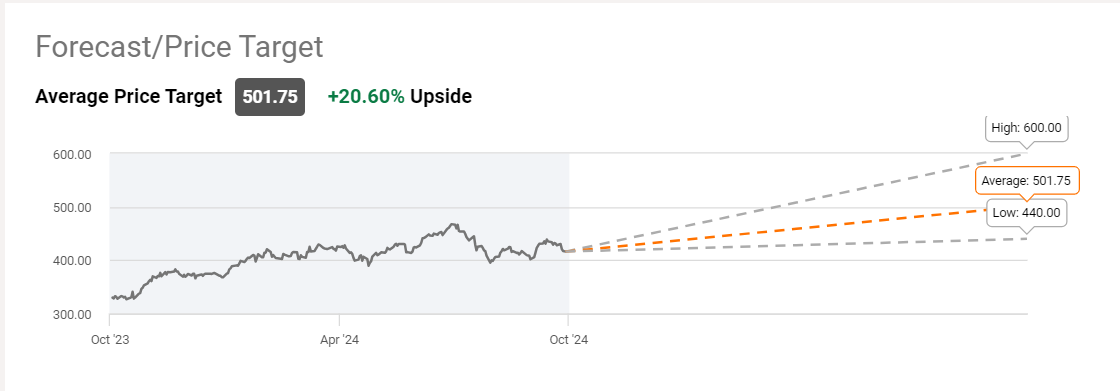Is MSFT Stock a Smart Buy


In our earlier article, How to Choose Stocks: A 7-Step Guide, we discussed why we like MSFT stock. We want to show you a real example of how we use our 7-step method to value stocks, focusing on Microsoft Corporation. We’ll examine the current market situation, analysts’ comments, and Microsoft’s financial performance to see if MSFT stock is a smart buy for investors right now.
Step 1 | Focus on Large Companies: Why MSFT Stock Fits
Microsoft Corporation (NASDAQ: MSFT) continues to be a major player in the tech industry. As of today, MSFT stock is trading at $418.74, with a market cap of $3.11 trillion, making it the second-largest publicly traded company in the world. MSFT covers that restriction.
Step 2 | Historical high percentage buy recommendations from stock analysts.
Currently, 52 out of 56 analysts (93%) have Buy or Strong Buy recommendations on MSFT. Historically, that ratio has been in the 90s and never under 85%. Interestingly enough, even in 2022, when the stock went down by 30%, the analysts were firm in their recommendations to Buy.
Step 3 | MSFT Stock Price Target Strategy: Aiming 20% Higher
The lowest analyst price target should not be much lower than the current price, and the average price target should be at least 20% higher.
This is the price target of MSFT stock:
MSFT’s current stock price is 415. The lowest price target is 440, while the average is 501.75. That is an excellent range of expectations for the stock.
Step 4 | Comparing Stock’s Forward P/E Ratios to the S&P 500
We believe that in the case of MSFT, the relevant index should be S&P500 Technology Index (XLK ETF):
| 2024 P/E | 2025 Forward P/E | 2026 Forward P/E | 2027 Forward P/E | 2028 Forward P/E | 2029 Forward P/E | |
| MSFT | 35,07 | 31,63 | 27,19 | 23,13 | 20,42 | 18,24 |
| S&P500 Technology Index | 40,41 | 34,88 | 30,10 | 25,98 | 22,42 | 19,35 |
MSFT is one of the very few companies with earnings estimates for the next 10 years. There are not that many stocks worldwide with such long-dated earnings estimates, and even in the case of MSFT, the number of analysts providing such estimates past 2028 is not that large.
Luckily, MSFT looked cheaper than the S&P500 Technology Index in all the years we examined, starting with 2025 to 2029 Forward PE Ratios.
Step 5 | Insider and Institutional Ownership Trends
The soft hurdle we have for step 5 at present is 70%. MSFT’s insider and institutional ownership rate is 74.28%. It is above 70% but not by much, which is a little bit of a red flag. We usually dig a little bit further to figure out why institutions don’t love MSFT more.
In this particular case, in our opinion, it is just about size. MSFT is an over 3 trillion USD company by market cap, so institutional investors need to be diversified. If the company was smaller, let’s say 1 Trillion USD in market capitalization, the institutional ownership rate would have been higher.
Step 6 | Short Float Analysis: Confidence in MSFT Stock
Looking at the table above, our readers can see that the short float is only 0.81%—well below our hurdle of 2%. Yes, practically nobody is betting MSFT will go down, which is quite comforting if you happen to have a long position.
Step 7 | Microsoft Corporation: A Proven Business Model Over 25 Years
MSFT has been one of the largest publicly traded companies in the world for the last 25 years. Clearly, they have withstood the test of time.
Step 8 | (Extra Step) Executing the Trade: Timing for MSFT Stock
This may be the hardest step of all.
First, MSFT reports Q3 2024 earnings on October 30th. Usually, this is a cause for concern for most stocks but not for MSFT:
According to zacks.com, MSFT has beaten earnings in 19 out of the last 20 earnings reports. The average beat is slightly less than 10%, and the only miss is 2%.
Statistics strongly suggest that MSFT will most likely beat earnings again. So, we will not wait for earnings to pass.
What percentage of our portfolio will we allocate to MSFT?
Probably not that much—certainly no higher than 10%. MSFT is a good company, and the upside of 20% based on the average stock price estimate is appealing, but there is always risk involved when it comes to single stocks—much higher than the risk associated with the S&P500.
What is our price target?
At least 20% upside. After reaching it, we might consider reducing the weight of the position or outright switching to SPY, but not before MSFT trades above 500 USD per share.
What about stops?
There is no price stop. We will use the average analyst price target as a stop. We will consider exiting the position before our target only if the average price estimate drops by more than 15%.



